Insights into microscopic oil occurrence characteristics in shales from the Paleogene Funing Formation in Subei Basin, China
IF 6
1区 工程技术
Q2 ENERGY & FUELS
引用次数: 0
Abstract
The microscopic occurrence characteristics primarily constrain the enrichment and mobility of shale oil. This study collected the lacustrine shales from the Palaeogene Funing Formation in the Gaoyou Sag, Subei Basin. Conventional and multistage Rock-Eval, scanning electron microscopy, and nuclear magnetic resonance (NMR) T1–T2 were performed to analyze the contents and occurrence characteristics of shale oil. Low-temperature nitrogen adsorption-desorption (LTNA/D) experiments were conducted on the shales before and after extraction. The relationships between shale oil occurrence with organic matter and pore structures were then discussed. Predominantly, the shale oil in the Funing Formation is found within fractures, with secondary occurrences in interparticle pores linked to brittle minerals and sizeable intraparticle pores associated with clay minerals. The selected shales can be categorized into two types based on the nitrogen isotherms. Type A shales are characterized by high contents of felsic and calcareous minerals but low clay minerals, with larger TOC and shale oil values. Conversely, Type B shales are marked by abundant clay minerals but diminished TOC and shale oil contents. The lower BET specific surface area (SSA), larger average pore diameter, and simpler pore surfaces and pore structures lead to the Type A shales being more conducive to shale oil enrichment and mobility. Shale oil content is predominantly governed by the abundance of organic matter, while an overabundance of organic matter typically equates to a reduced ratio of free oil and diminished fluidity. The BET SSA, volumes of pores less than 25 and 100 nm at extracted state all correlate negatively with total and adsorbed oil contents but display no correlation with free oil, while they have positive relationships with capillary-bound water. Consequently, pore water is mainly saturated in micropores (<25 nm) and minipores (25–100 nm), as well as adsorbed oil, while free oil, i.e., bound and movable oil, primarily exists in mesopores (100–1000 nm) and macropores (>1000 nm). These findings may enhance the understanding of the microscopic occurrence characteristics of shale oil and will contribute to guide resource estimation and shale oil sweet spot exploitation in the Gaoyou Sag, Subei Basin.
求助全文
约1分钟内获得全文
求助全文
来源期刊

Petroleum Science
地学-地球化学与地球物理
CiteScore
7.70
自引率
16.10%
发文量
311
审稿时长
63 days
期刊介绍:
Petroleum Science is the only English journal in China on petroleum science and technology that is intended for professionals engaged in petroleum science research and technical applications all over the world, as well as the managerial personnel of oil companies. It covers petroleum geology, petroleum geophysics, petroleum engineering, petrochemistry & chemical engineering, petroleum mechanics, and economic management. It aims to introduce the latest results in oil industry research in China, promote cooperation in petroleum science research between China and the rest of the world, and build a bridge for scientific communication between China and the world.
 求助内容:
求助内容: 应助结果提醒方式:
应助结果提醒方式:


